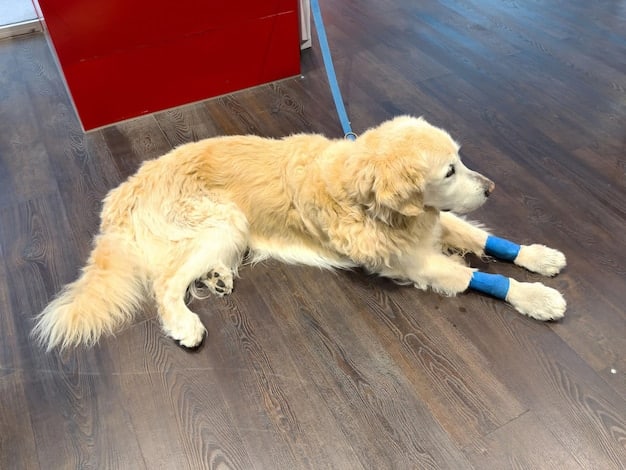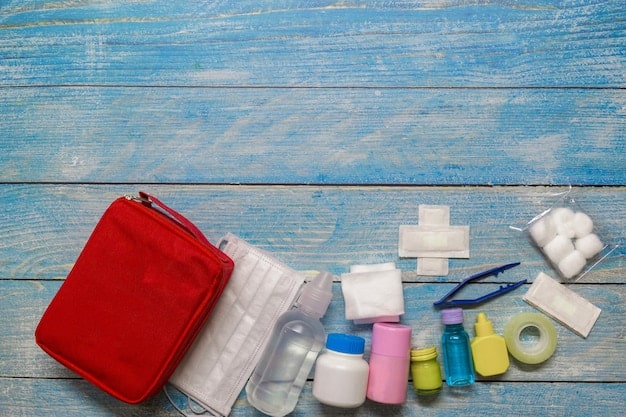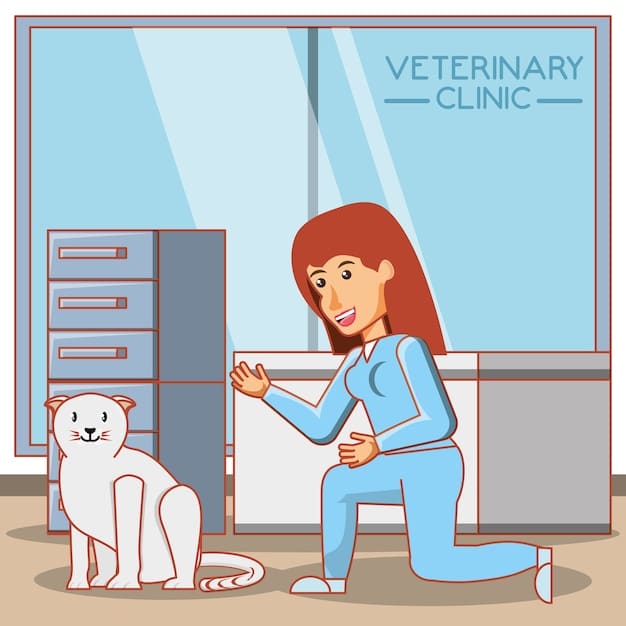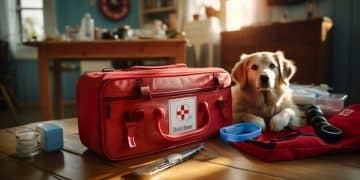Pet First Aid: Essential Guide to Home Emergencies

Pet first aid involves immediate care for injured or sick pets at home before veterinary help arrives, including knowing basic techniques and assembling a comprehensive kit to handle common emergencies effectively.
Every pet owner hopes to never face a situation where their beloved companion is injured or in distress. However, being prepared with basic pet first aid knowledge can make all the difference in ensuring their safety and well-being before you can reach professional veterinary care.
Understanding Pet First Aid
Pet first aid is the immediate assistance given to an injured or ill animal. Like human first aid, it buys time and stabilizes the pet until professional veterinary care is available. Knowing how to respond in those critical moments can significantly improve your pet’s chances of recovery.
Why Pet First Aid Matters
Accidents and sudden illnesses can happen at any time. Being equipped to handle these situations can prevent further injury, alleviate pain, and even save your pet’s life. The knowledge and skills gained from pet first aid can provide peace of mind, knowing that you’re prepared to act effectively.
Essential First Aid Skills
Key skills involve recognizing signs of distress, controlling bleeding, administering CPR, and managing common emergencies like choking or poisoning. Each skill requires specific techniques, which are best learned through certified pet first aid courses.
- Recognizing abnormal vital signs
- Controlling bleeding and bandaging wounds
- Performing CPR and rescue breathing
- Managing common emergencies, such as choking
In conclusion, understanding pet first aid is crucial for every pet owner. Being prepared and knowing how to act in an emergency can significantly impact your pet’s well-being and recovery. Investing in pet first aid knowledge is a valuable step in responsible pet ownership.
Assembling a Pet First Aid Kit
A well-stocked pet first aid kit is an essential component of being prepared for emergencies. Having the right supplies on hand allows you to address injuries and illnesses quickly and efficiently.

What to Include in Your Kit
Equipping a comprehensive kit involves gathering items to address various potential issues, from minor cuts to more severe situations. Always check expiration dates and replenish items as needed.
- Bandages and Gauze: For wound care and securing dressings.
- Antiseptic Wipes: Cleaning wounds to prevent infection.
- Tweezers: Removing splinters or debris.
- Thermometer: Monitoring your pet’s temperature.
Medications and Other Essentials
Certain medications and tools can be valuable additions to your kit. However, always consult with your veterinarian before administering any medication to your pet.
- Saline Solution: For flushing wounds or eyes.
- Hydrogen Peroxide: Inducing vomiting in certain poisoning cases (consult vet first).
- Pet Carrier: Safely transporting your pet if needed.
- Emergency Contact Information: Including your vet’s number and a poison control hotline.
Creating and maintaining a well-stocked pet first aid kit is a fundamental step in ensuring your pet’s safety. Regular checks and updates will keep you prepared for any unexpected health issue that may arise.
Recognizing Signs of Pet Emergencies
Early recognition of emergency symptoms is crucial in providing timely and effective care. Knowing what is normal for your pet will allow you to quickly identify any deviations that signal a potential problem.
Observe Normal Behavior
Pay attention to your pet’s usual behavior, appetite, and energy levels. Any significant change could be an indicator of an underlying issue.
Key Warning Signs
Be alert for symptoms such as difficulty breathing, excessive bleeding, sudden collapse, or signs of severe pain. These are all red flags that require immediate attention.
- Difficulty Breathing: Gasping, rapid breathing, or blue gums.
- Excessive Bleeding: Bleeding that doesn’t stop within a few minutes.
- Sudden Collapse: Loss of consciousness or inability to stand.
- Signs of Severe Pain: Whimpering, panting, or reluctance to move.
Recognizing these signs early can make a significant difference in the outcome of an emergency. Prompt action and a quick response can save your pet’s life. Be vigilant and trust your instincts when it comes to your pet’s health.
Handling Common Pet Emergencies at Home
Knowing how to handle common pet emergencies at home can help stabilize your pet until you can seek professional veterinary care. Each emergency requires specific actions to ensure the pet’s safety.
Wound Care and Bleeding
For minor cuts, clean the wound thoroughly with antiseptic wipes and apply a bandage. In cases of excessive bleeding, apply direct pressure with a clean cloth and elevate the injured area.
Choking
If your pet is choking, check their mouth for any visible obstructions. If you can see an object, attempt to remove it carefully. If not, perform the Heimlich maneuver by giving quick, forceful thrusts to the abdomen.

Poisoning
If you suspect your pet has ingested poison, immediately contact your veterinarian or a poison control hotline. Do not induce vomiting unless instructed to do so by a professional.
- Identify the poison.
- Call your vet immediately.
- Follow instructions carefully.
Being prepared to handle these common emergencies can help you act quickly and effectively in a crisis. Remember, the goal is to stabilize your pet until you can get them to a veterinarian.
Administering Pet CPR
Cardiopulmonary Resuscitation (CPR) is a lifesaving technique that can help revive a pet whose breathing or heart has stopped. Knowing how to perform CPR can provide your pet with a chance of survival.
Assessing the Situation
Before starting CPR, check for signs of breathing and a heartbeat. If there are no signs of life, begin CPR immediately.
CPR Techniques
For dogs and cats, place them on their right side and perform chest compressions by placing your hands over their heart. Give rescue breaths by sealing your mouth over the pet’s nose and mouth and gently breathing into them.
- Check for signs of life: Look, listen, and feel.
- Chest compressions: 100-120 compressions per minute.
- Rescue breaths: Give 2 breaths every 30 compressions.
Continuing CPR
Continue CPR until your pet shows signs of life or until you reach veterinary care. Even if your pet seems to revive, it’s crucial to seek professional medical attention as soon as possible.
Learning and practicing pet CPR can empower you to act in a critical situation. While it’s not a substitute for professional veterinary care, it can be a bridge to survival until help arrives.
Preventative Measures to Avoid Emergencies
Preventing emergencies is always better than reacting to them. Taking proactive steps can help minimize the risks your pet faces and ensure their overall safety.
Home Safety Checks
Regularly inspect your home for potential hazards, such as toxic substances, sharp objects, and electrical cords. Store chemicals and medications out of your pet’s reach.
Safe Environment
Create a safe environment by ensuring your pet has adequate space, proper ventilation, and protection from extreme temperatures. A secure fence can prevent escapes and potential accidents.
- Secure toxic products.
- Cover electrical cords.
- Ensure your pet has ID.
Regular Vet Check-ups
Schedule regular check-ups with your veterinarian to detect and address any health issues early. Vaccinations and parasite prevention are also crucial for maintaining your pet’s well-being.
Taking preventative measures is an investment in your pet’s health and safety. By being proactive and vigilant, you can significantly reduce the likelihood of emergencies and provide your pet with a happy and healthy life.
| Key Point | Brief Description |
|---|---|
| ⛑️ Pet First Aid Kit | Assemble a kit with bandages, antiseptic, tweezers, and other essentials. |
| 🤕 Recognizing Signs | Be alert for difficulty breathing, bleeding, or sudden collapse. |
| ❤️ Administering CPR | Perform chest compressions and rescue breaths if your pet stops breathing. |
| 🛡️ Preventative Measures | Secure your home, ensure a safe environment, and schedule regular vet check-ups. |
Frequently Asked Questions (FAQ)
A pet first aid kit should include bandages, antiseptic wipes, tweezers, a thermometer, saline solution, and emergency contact information. You should also consult with your vet about specific medications that may be helpful for your pet.
Key signs of a pet emergency include difficulty breathing, excessive bleeding, sudden collapse, signs of severe pain, and disorientation. Any significant change in your pet’s behavior or vital signs should be taken seriously.
To perform CPR on your pet, place them on their right side, perform chest compressions at a rate of 100-120 compressions per minute, and give rescue breaths by sealing your mouth over their nose and mouth, breathing gently into them.
If you suspect your pet has ingested poison, immediately contact your veterinarian or a poison control hotline. Do not induce vomiting unless instructed to do so by a professional, as some substances can cause more harm if vomited.
Prevent pet emergencies by regularly inspecting your home for hazards, storing chemicals and medications out of reach, ensuring a safe environment, and scheduling regular vet check-ups. Also, ensure your pet has proper identification.
Conclusion
Being equipped with pet first aid knowledge and a well-stocked kit can make all the difference in an emergency. By staying vigilant, taking preventative measures, and knowing how to respond in critical situations, you can provide your beloved companion with the best possible care until professional veterinary help arrives.





